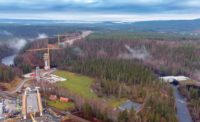
Rolling and rising methodically into place over the next month, 12 arches are forming what Texas Dept. of Transportation officials believe will be the world's first precast-concrete network-arch bridge. The novel design's ultimate goal is to alleviate congestion in the Fort Worth corridor. The new West 7th Street Bridge posed big post-tensioning and placement challenges for the contracting team.
The new structure will replace the current 972-ft-long, 57-ft-wide crossing over the Trinity River, built in 1913 and serving as an increasingly busy link between downtown Fort Worth and the expanding Cultural District. Corporations agreed to donate land for construction operations supporting the signature, 88-ft-wide bridge, which will have a center median and separate bike-pedestrian paths.
The first two of twelve 163-ft-long arches were set in early May under Sundt Construction Co.'s $24-million contract. As of the beginning of June, six remain, says Chris Cedar, Sundt project manager and Texas area manager.
Infinity Engineering served as construction engineer for the process in which self-propelled mobile transporters (SPMTs) roll one arch at a time across the old bridge. Then, using twin superlift cranes with a capacity of 340,000 lb at 95 ft, Sundt will place each 640,000-lb arch into place on either side of the old bridge.
Considering that each arch, the SPMTs and the bracing meant some one million pounds of gross weight on the old bridge, "a lot of engineering went into figuring out its capacities and what it could handle," says John E. Carlson, Sundt senior vice president. "[Dan Brown and Associates] did a full geotechnical analysis to make sure the cranes would be supported," Carlson notes. "Each crane location was engineered. There was no guessing. One of the crane locations required 48-in. drill shafts to transfer some of the load down to the rock formation about 45 feet deep because the crane sits on the slope of the river."
Off-site precasting "was a huge selling point" for the community, notes Texas Dept. of Transportation spokesperson Val Lopez. "To shut down the bridge for an entire year was difficult to sell. Here, it's a few months." The contractor stands to earn up to $30,000 a day in early completion bonuses before the 150-calendar-day deadline, adds Lopez. The new bridge is scheduled to open in early October.
Crews began precasting the arches on their sides, then post-tensioned them in a three-step process, Carlson says. "Initially, we post-tensioned them on their sides on corners, then we post-tensioned them up to the point where we could rotate them." Workers rotated the arches into vertical position with a gantry system and strand jacks. "Then, we slid them—after another post-tensioning— sideways into the storage area and de-tensioned them back into the final design requirement."
Traffic is reduced to one lane in each direction during arch placement. "Once all the arches are set, we will go in and tear out the old bridge," says Carlson. Traffic will be shut down for 150 days once demolition begins, he says. Cedar notes that demolition activities and floor-beam placement must occur beneath some 19 ft of clearance from the deck to overhead bracing beams, two per pair of arches.
The 20-ft-tall precast arches rise above the deck and use 1¾-in.-thick stainless-steel hangar rods in a crisscrossing mesh pattern. The concept of a precast tied-arch bridge came up over a deacade ago, says Dean Van Landuyt, senior bridge design engineer with TxDOT's Austin office. "We wanted to use a network arch in a way it hasn't been used. Instead of widely spaced hangars, we wanted a thick, metallic mesh for a screening effect and to create architectural interest. We wanted a through arch so that pedestrians and motorists could experience it, and we wanted a precast arch [so that we could] build it more quickly and stay out of motorists' way."
Since the original idea was conceived, the evolution of lifting technologies coupled with the ideal site geometry made the precast tied-arch design feasible for this project, Van Landuyt says.





